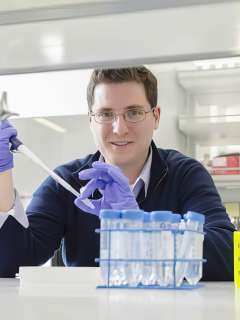
Mitchell Guttman, PhD
Institutional Affiliation
Languages
Education
Degrees
Contact Information
Phone
Scientific Interests
It is now clear that the mammalian genome encodes many thousands of long non-coding RNAs (lncRNAs). These lncRNAs are emerging as an important component in cellular regulation and play critical roles in diverse biological processes including embryonic development. Importantly, their misregulation has been implicated in numerous cancers through their roles as tumor suppressor genes and oncogenes. While it is clear that lncRNAs can play important roles in cancer formation and metastasis, how they give rise to these processes is unclear. The research in Dr. Guttman's lab aims to dissect the mechanisms by which lncRNAs act to regulate gene expression. His lab has developed numerous tools to study RNA biology – including biochemical methods to comprehensively define proteins that interact with a specific RNA [McHugh et al. 2015 Nature], molecular methods to map RNAs to chromatin [Engreitz et al. 2013 Science] and pre-mRNA [Engreitz et al. 2014 Cell], and genomic methods for mapping higher-order 3D organization of RNA and DNA in the nucleus [Quinodoz et al. 2018 Cell]. His lab's work has uncovered a key role for lncRNAs in exploiting 3-dimensional genome organization [Engreitz et al. 2013 Science and McHugh et al. 2015 Nature] and showed that lncRNAs can shape 3D chromosome architecture to regulate gene expression [Chen et al. 2016 Science]. This work has led to new paradigms in understanding the role of 3-dimensional genome organization in gene regulation and may explain how dysregulation of individual lncRNAs can lead to various human cancers.
Highlighted Publications
Arrastia MV, Jachowicz JW, Ollikainen N, Curtis MS, Lai C, Quinodoz SA, Selck DA, Ismagilov RF, Guttman M (2021). A single-cell method to map higher-order 3D genome organization in thousands of individual cells reveals structural heterogeneity in mouse ES cells. Nature Biotechnology (in press).
Bhat P, Honson D, Guttman M. Nuclear compartmentalization as a mechanism of quantitative control of gene expression. Nature Reviews Molecular Cell Biology, doi: 10.1038/s41580-021-00387-1. PMID: 34341548.
Banerjee AK, Blanco MR, Bruce EA, Honson DD, Chen L, Chow A, Bhat P, Ollikainen N, Quinodoz SA, Loney C, Thai J, Miller ZD, Lin AE, Schmidt MM, Stewart DG, Goldfarb D, De Lorenzo G, Rihn SJ, Voorhees R, Botten JW, Majumdar D, and Guttman M (2020). SARS-CoV-2 suppresses mRNA splicing, translation, and protein trafficking in a multipronged mechanism to evade host defenses. Cell Nov 25;183(5):1325-1339.e21
Quinodoz SA, Bhat P, Ollikainen N, Jachowicz JW, Banerjee AK, Chovanec P, Blanco MR, Chow A, Markaki Y, Plath K, and Guttman M (2020). RNA promotes the formation of spatial compartments in the nucleus. bioRxiv doi: https://doi.org/10.1101/2020.08.25.267435
Vangala P, Murphy R, Quinodoz SA, Gellatly K, McDonel PE, Guttman M, Garber M (2020). High-resolution mapping of multiway enhancer promoter interactions regulating pathogen detection. Molecular Cell doi: 10.1016/j.molcel.2020.09.005.